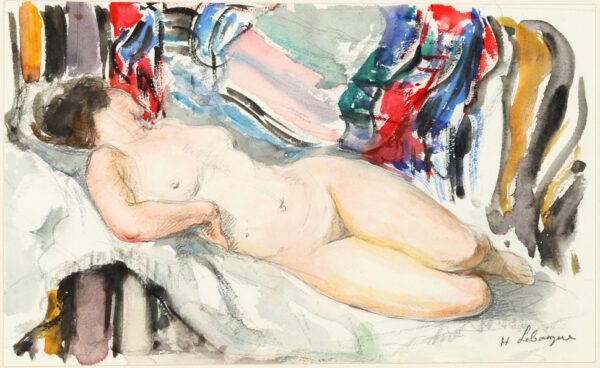‘’Nu Couché’’
Watercolour and pencil: 15 x 25 cm
Signed (l.r.): ‘H Lebasque’
"*" indicates required fields
Notes
Henri Lebasque was a French post-impressionist painter. He was born at Champigné (Main-et-Loire). His work is represented in French museums, notably Angers, Geneva (Petit Palais), Lille (Musée des Beaux-Arts), Nantes, and Paris (Musée d’Orsay).
He started his education at the École régionale des beaux-arts d’Angers, and moved to Paris in 1886. There, Lebasque started studying under Léon Bonnat, and assisted Ferdinand Humbert with the decorative murals at the Panthéon. Around this time, Lebasque met Camille Pissarro and Auguste Renoir, who later would have a large impact on his work.
Lebasque’s vision was coloured by his contact with younger painters, especially Édouard Vuillard and Pierre Bonnard, founders of Les Nabis a group of Intimist painters that first favoured the calm and quietude of domestic subject matter. From his first acquaintance with Georges Seurat and Paul Signac, Lebasque learnt the significance of a colour theory which stressed the use of complementary colours in shading
Lebasque was a founding member of the Salon d’Automne in 1903 with his friend Henri Matisse and exhibited at the Salon des Indépendants. Two years later, a group of artists exhibited there including Georges Rouault, André Derain, Henri Ottmann, Édouard Vuillard, and Matisse. Lebasque also became friends with artists such as Raoul Dufy, Louis Valtat, and Henri Manguin, the last of whom introduced Lebasque to the South of France.
His time in South of France would lead to a radical transformation in Lebasque’s paintings, changing his colour palette forever. Other travels included the Vendée, Normandy, and Brittany.
Lebasque had some commercial success during his lifetime. He worked on the decorations at the theatre of the Champs-Elysées and of the Transatlantique sealiner.
Lebasque died at Cannet, Alpes Maritimes in 1937.
This watercolour looks to be a study for two larger paintings the artist made: ‘Nu aux draperies’ (‘’Henri Lebasque Catalogue Raissonné – Tome 1’, Denise Bazetoux, 2008, no. 957, page 247) & ‘Nu couché’ (‘’Henri Lebasque Catalogue Raissonné – Tome 1’, Denise Bazetoux, 2008, no. 958, page 247).
Provenance
- A private Dutch collection;
- thence by descent to the present owner
Expertise
The authenticity of this work has been confirmed by Mrs Denise Bazetoux on 17 January 2020.

